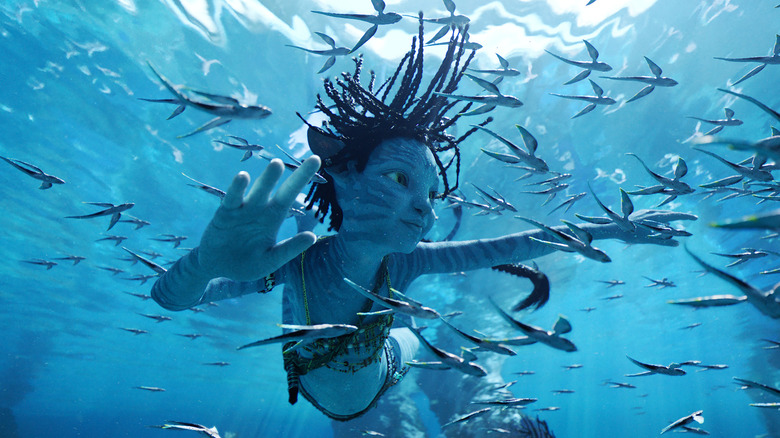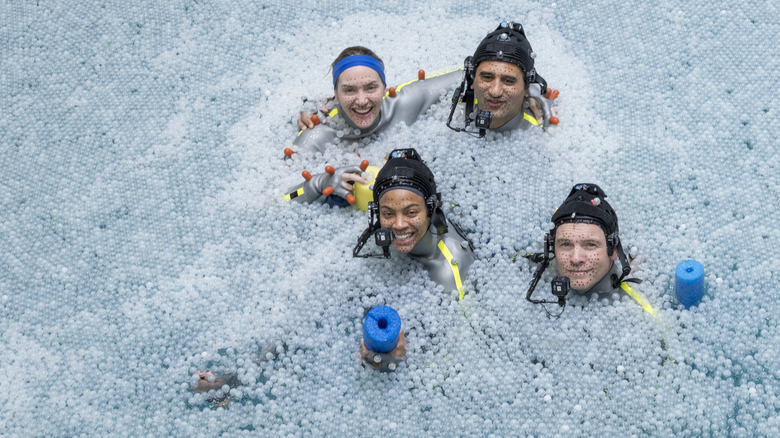Avatar: The Way Of Water's Tech Team Tried To Convince James Cameron To Avoid Filming Underwater
The "Avatar" films are some of the greatest visual marvels of the past 20 years and otherwise incredible works of VFX artistry and tech wizardry. But as impressive as the first movie was (a significant enough achievement to be included in the big ode to cinema montage at the end of Damien Chazelle's "Babylon"), the second film, "The Way of Water," blows its predecessor out of the water (pun very much intended).
Without a doubt, the most impressive thing "The Way of Water" does is water itself, not only in terms of how photorealistic it looks, but how it interacts with the environment and characters. That's because, as James Cameron notes in the new Disney+ documentary "Fire and Water: Making the Avatar Films," every character movement and expression you see is performed in-camera on a set, whether it's on land or underwater.
This, unsurprisingly, is not easy. As Cameron himself puts it in the opening minutes of the documentary, "The second you decide to make a movie in and underwater, and make it look like you're at sea, you've just opened up a gigantic can of whoop-ass on yourself."
Indeed, it was a logistical nightmare, so much so that the crew practically begged Cameron to consider alternatives. Second unit director and stunt coordinator Garrett Warren said he pitched "a bunch of different times" to Cameron to try and convince him to shoot the film "on land" by hanging the actors from wires and making them look like they are moving underwater with visual and special effects. This is how movies like "Aquaman" and Disney's live-action "The Little Mermaid" were made.
But, of course, James Cameron doesn't do what James Cameron does for James Cameron. James Cameron does what James Cameron does because James Cameron is ... James Cameron.
Avatar: The Way of Water and the dry for wet theory
For a while, the Research and Development team for "The Way of Water" attempted to pull off the underwater stunts using wire rigs and winch systems like the kind you see in a football stadium for the cameras that fly around the field. The actors would then be suspended on wires and harnesses and swim through the air since, as visual production supervisor Ryan Champney remarked, the film's creatives weren't sure they could do performance capture underwater given the sheer number of actors required for each scene.
The result is quite impressive and the stuntwork seems quite effective, with production designer Dylan Cole admitting, "It was some of the best wire work you'd ever seen, but the instant you see it side by side with something that's actually captured in water, it's instantly identifiable, and you just cannot fake that."
"There's no hiding from the physics when you're doing capture," Cameron observed. "People have to actually do it. Because the physics translate all the way through to the final thing, and that either looks right, or doesn't." The key is the resistance; the pushback from and interaction with the water itself (i.e. the density of the water) affects every single movement, which makes all the difference.
Performing underwater is easier said than done, though, and it led to the biggest challenge for the movie — not to mention, arguably the biggest advancement in performance capture since the modern "Planet of the Apes" movies managed to do performance capture outdoors. This is also the crux of the documentary, which explores just how the crew behind "The Way of Water" managed to solve the underwater issue.
Solving the water issue in Avatar: The Way of Water
One of the immediate problems was how to actually capture the performances, because it turns out standard infrared cameras just don't work underwater. (The light simply doesn't reach them.) The solution, then, was to use ultraviolet light, which works underwater but not above water. That meant doing two performance capture set ups or "volumes," including one for underwater performance and one for above water action.
But there was another problem: Any bubbles in the water caused by breathing would be captured by the cameras as if they were little performance capture balls, and mess up the whole thing. This is why the "Way of Water" cast trained to perform their underwater scenes while holding their breath the entire time, with Kate Winslet even breaking Tom Cruise's breath-holding record in the process.
Truly, the "Way of Water" documentary is worth watching just to appreciate the sheer magnitude of work that went into solving the film's water problem. Among other things, that meant building a mechanical set that could be lifted above water for set dressing and then lowered under water for shooting, using actual ship propellers to create underwater currents for realism, and giving the film's cast underwater jetpacks to improve their mobility.
Doing dry for wet made sense, naturally, as it would've been much easier and certainly a lot cheaper than to actually film most of the action underwater. Then again, as "South Park" once taught us, there's no budget too steep, and no sea too deep, for James Cameron.
The first two "Avatar" films are currently streaming on Disney+. "Avatar: Fire and Ash" opens in theaters on December 19, 2025.


